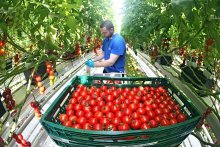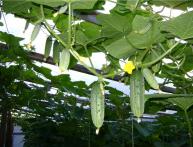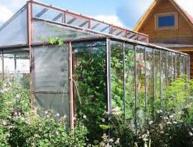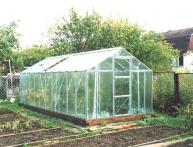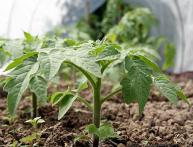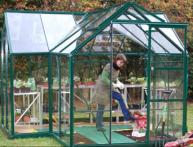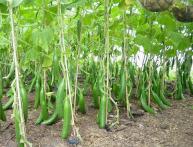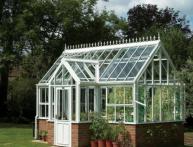Growing tomatoes in a polycarbonate greenhouse: from choosing a variety to harvesting

Growing tomatoes, like other vegetables and fruits, always requires effort, time and certain skills. There will be no exception cultivation vegetables and fruits in greenhouse conditions. To get a good harvest, you need to pay special attention to some stages, which will be discussed below.
Content:
- Choosing a variety for the greenhouse
- Sowing seeds for seedlings
- Preparing the greenhouse for planting seedlings
- Transplanting
- Basic care measures
Choosing a variety for the greenhouse
Growing tomatoes in a greenhouse has its own characteristics. Therefore, when choosing seeds, the first thing you should pay attention to is the growing conditions. Only those varieties that are intended for cultivation in closed ground conditions are suitable for the greenhouse.
Next, you need to clearly understand the purpose of the future harvest. If you plan only to use fresh, then salad varieties are suitable for you. If the goal is preservation, then preference should be given to canned varieties. Well, if the use is multifaceted, then you should safely purchase varieties for universal use.
Also varieties intended for cultivation in the greenhouse must meet the following characteristics:
- To be indeterminate, that is, tall. They have unlimited growth and are therefore able to bear fruit until late autumn.
- Be resistant to major diseases, since the humid environment of the greenhouse contributes to the accelerated spread of various pathogenic microorganisms.
- Have high yields. You should not take up scarce space in the greenhouse with low-yielding varieties.
Sowing seeds for seedlings
In order for the seeds of the selected variety to produce friendly and healthy seedlings, they must first be prepared. To do this, you can carry out their basic disinfection in a pink solution of potassium permanganate. Various growth stimulants can also be used to improve germination energy. For example, Epin or Zircon show good results.
Attention! Some manufacturers package already processed seeds. They can be distinguished by their painted surface. Such seeds do not require additional processing.
You can prepare the soil for sowing yourself from equal parts of turf soil, humus and sand, or purchase ready-made soil for growing seedlings. When sowing, the seeds are planted to a depth of 0.5 cm, after which the seed containers are watered and placed in a warm place. Under favorable conditions, the first shoots may appear as early as 3 or 4 days.
Further care of the seedlings consists of regular watering. When 3 or 4 true leaves appear, start picking the seedlings into separate containers. Tip! At picking Be sure to shorten the central root of seedlings. This technique promotes the development of the root system.
Preparing the greenhouse for planting seedlings
They begin to prepare the greenhouse for planting seedlings in early March. At this time, it is already warming up enough in the sun. And the soil in it begins to gradually thaw. Preparatory work should begin with disinfection.To do this, they use sulfur bombs, which fumigate the greenhouse.
Attention! When using sulfur bombs, you must act as carefully as possible. Since they are highly toxic to humans and other warm-blooded animals. After disinfection, you can begin preparing the soil. To do this, perform the following activities:
- Digging up the soil
- Apply fertilizers
- Setting up beds
Once the greenhouse is prepared, you can begin planting seedlings.
Transplanting
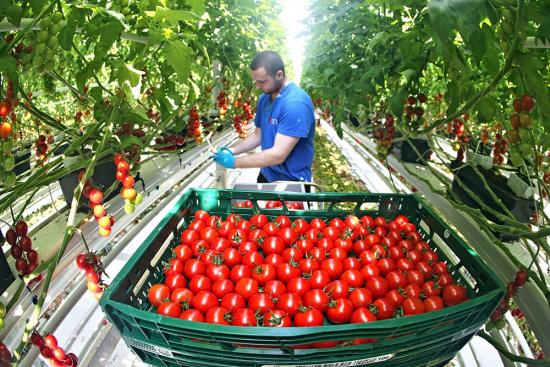
When planting tomato seedlings in a greenhouse, you need to follow these simple rules. At the time of planting seedlings, the soil must warm up well. If you neglect this and plant tomatoes in cold soil, then the root system will simply stop developing and the plants will stop growing for a long time, and some of them may die.
Planting is best done in the evening or on a cloudy day. This way plants recover faster and adapt to new conditions.
When planting, you do not need to add too much organic fertilizer in the form of humus or compost. Just one handful is enough for each hole. Also, when landing Plants should be placed based on their height. You should not alternate tall people with medium and short people.
Basic care measures
Timely care is the key to a high yield. You should start caring for plants immediately after planting the seedlings.
Watering mode
You should not water tomatoes the first few days after planting. At this time, their root system is especially sensitive to excess moisture.And for growth and development, the water that was used for irrigation during planting is enough for them. Before flowering, tomatoes are watered 1-2 times a week, while about half a bucket of water is spent per 1 square meter of area.
After the bushes bloom, watering should be increased to 1.5 buckets of water per square meter. Advice! It is not recommended to use cold irrigation water. It is best if its temperature is 20-25°. It is also best to water tomato bushes in the morning and evening hours. This will help avoid burns from the sun's rays when water gets on the leaves.
Ventilation and garter
The greenhouse is an artificially created environment, so it must be ventilated. Ventilation also helps maintain an optimal ratio of humidity and temperature. Tomatoes practically do not react to drafts, so you can ventilate them in any convenient and accessible way. For example, you can open two windows in different parts of the greenhouse, or use a door and a window.
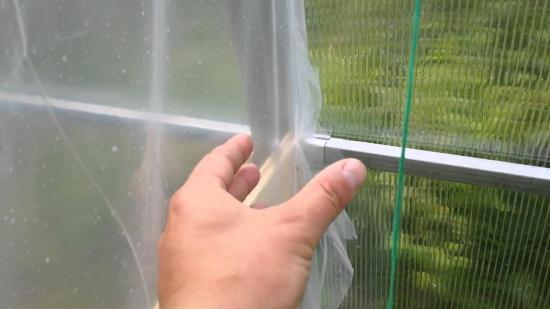
Tomatoes, growing in a greenhouse, must be tied up. You should start within a week after disembarkation. To do this, trellises of a linear or frame design are installed in the greenhouse. With the help of a garter, tall tomato bushes are supported in the desired position. As a result, light and humidity are maintained at the required level, and fruit harvesting is also facilitated.
Stepping and feeding
Tomatoes growing in a greenhouse should be pinched. This avoids unnecessary thickening of plantings. Most often, depending on the variety, plants growing in a greenhouse are formed into one or 2 stems. The first pinching should be carried out at the time of planting the seedlings. It is then carried out as needed.
The tomatoes are fed for the first time 2 weeks after planting. To do this, you can use a mixture of mullein infusion and nitroammophoska. To prepare it, add half a liter of pre-fermented mullein and 1 tablespoon of nitroammophoska to a bucket of water. About 1 liter of this mixture is consumed for each plant.
Attention! Fertilizer should be watered only at the root and strictly on damp soil.
After 15 days, the next feeding is carried out. To do this, use 1 teaspoon of any potash fertilizer and any humic fertilizer according to the attached instructions. They are bred in a bucket of water. Each bush also consumes about 1 liter of this mixture. In total, from 3 to 4 feedings are carried out per season.
Pollination
Most often, there are no pollinating insects in the greenhouse. Therefore, to obtain a high yield, plants need to be pollinated. It's very easy to do. You need to choose a sunny day and gently shake each flower brush. You can also tap the trellis to shake up the tomato plants.
After this, immediately the plants themselves watered, and the brushes are sprayed with water. 2 hours after this, the greenhouse is ventilated. It is very important to ensure that condensation does not collect on the polycarbonate walls during fruit filling. High humidity at this moment will greatly affect the taste of the fruit.
With excess moisture, a tomato loses its sugar content and friability and acquires a watery and sour taste. If you strictly adhere to all of the above recommendations, you can grow a bountiful harvest of tasty and aromatic tomatoes with your own hands.
Video about growing tomatoes in a greenhouse and outside a greenhouse:

